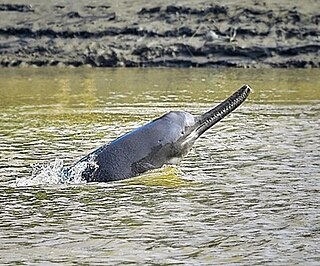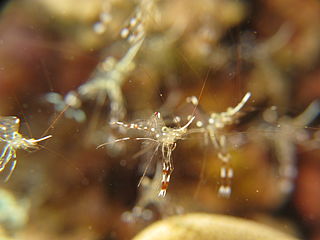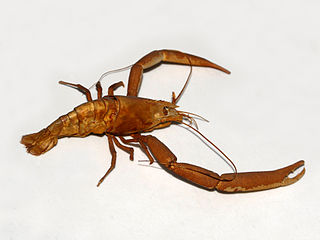
South Asian river dolphins are toothed whales in the genus Platanista, which inhabit the waterways of the Indian subcontinent. They were historically considered to be one species with the Ganges river dolphin and the Indus river dolphin being subspecies. Genetic and morphological evidence led to their being described as separate species in 2021. The Ganges and Indus river dolphins are estimated to have diverged 550,000 years ago. They are the only living members of the family Platanistidae and the superfamily Platanistoidea. Fossils of ancient relatives date to the late Oligocene.

Sawfish, also known as carpenter sharks, are a family of rays characterized by a long, narrow, flattened rostrum, or nose extension, lined with sharp transverse teeth, arranged in a way that resembles a saw. They are among the largest fish with some species reaching lengths of about 7–7.6 m (23–25 ft). They are found worldwide in tropical and subtropical regions in coastal marine and brackish estuarine waters, as well as freshwater rivers and lakes. All species are endangered.

Macrobrachium rosenbergii, also known as the giant river prawn or giant freshwater prawn, is a commercially important species of palaemonid freshwater prawn. It is found throughout the tropical and subtropical areas of the Indo-Pacific region, from India to Southeast Asia and Northern Australia. The giant freshwater prawn has also been introduced to parts of Africa, Thailand, China, Japan, New Zealand, the Americas, and the Caribbean. It is one of the biggest freshwater prawns in the world, and is widely cultivated in several countries for food. While M. rosenbergii is considered a freshwater species, the larval stage of the animal depends on brackish water. Once the individual shrimp has grown beyond the planktonic stage and becomes a juvenile, it lives entirely in fresh water.
Cryphiops caementarius is a South American freshwater shrimp.

Palaemon serratus, also called the common prawn, is a species of shrimp found in the Atlantic Ocean from Denmark to Mauritania, and in the Mediterranean Sea and Black Sea.
Macrobrachium agwi is a species of freshwater shrimp, first described in 2008, endemic to the Himalaya. It was discovered when a shipment of ornamental prawns, destined for the aquarium trade, was shipped from Cooch Behar, West Bengal, India to Europe. Examination of the shipment showed that one type of shrimp was a new, undescribed species.

Macrobrachium ohione, commonly known as the Ohio shrimp, Ohio river shrimp or Ohio river prawn, is a species of freshwater shrimp found in rivers throughout the Gulf of Mexico and Atlantic Ocean drainage basins of North America. It is the best-known of all North American freshwater shrimp, and is commonly used as bait for commercial fishing, especially catfish.

Macrobrachium is a genus of freshwater prawns or shrimps characterised by the extreme enlargement of the second pair of pereiopods, at least in the male.

Urocaridella antonbruunii, common names clear cleaner shrimp or red-white cleaner shrimp, is a species of shrimp belonging to the family Palaemonidae. It was described by A. J. Bruce in 1967. It is one of the species that are known as cleaner shrimps.

Macrobrachium carcinus is a species of fresh water shrimp known as the big claw river shrimp. It is native to streams, rivers and creeks from Florida to southern Brazil. It is the largest known species of Neotropical freshwater prawn, growing up to 30 centimetres (12 in) long and weighing as much as 850 grams (30 oz), although even larger specimens have been reported. It is an important species for commercial fishing in the Sao Francisco area, where it is known by the local name of pitu. M. carcinus is omnivorous, with a diet consisting of molluscs, small fish, algae, leaf litter and insects.
Macrobrachium crenulatum is an amphidromous freshwater shrimp of the Palaemonidae family in the Decapoda order. It is found in lowland rivers and streams from Panama to Venezuela, as well as on several Caribbean islands. The species is common in the Toro Negro State Forest in central Puerto Rico. Studies have shown that the species have higher sensitivity to environmental, hydrological and chemical factors than other crustaceans also studied and which affect its migratory patterns.

Macrobrachium formosense, the crane river prawn, is a species of freshwater shrimp in the family Palaemonidae. It lives in streams and rivers in Taiwan and southern Japan, including the Ryukyu Islands. Macrobrachium formosense reaches a carapace length of 10–20 millimetres (0.4–0.8 in).
Macrobrachium vollenhoveni, the African river prawn, is a species of large, commercially important prawn from the family Palaemonidae from West Africa. It is a catadromous species that moves from freshwater to brackish water to spawn returning to freshwater as larvae. Recent research has shown that it could potentially be used as a biological control to reduce the rates of infection people living near rivers where this species occurs with schistosomiasis.

Macrobrachium nobilii is a species of freshwater shrimp, first described by Henderson and Matthai, 1910. It belongs to the order Decapoda and family Palaemonidae.
Macrobrachium scabriculum is a species of freshwater shrimp. It is distributed in countries and territories around the Indian Ocean. It is known as Goda River prawn. The total length of male prawns become about 6.5 cm long and in females it is about 5 cm. A kind of fur develop on the chelipeds of males. Eggs produced by M. scabriculum are smaller in size, brownish in color, elliptical or oval in shape and hatched larvae undergone migration to low saline water for completion its life cycle.
Macrobrachium indicum is a species of freshwater shrimp of South India. It was first described in 1986. This freshwater prawn was described from Vellayani Lake, Kerala. This species is closely related to M. australe and M. ustulatum. It is a medium-sized prawn of genus Macrobrachium.
Macrobrachium banjarae is a species of freshwater shrimp that was first described in 1958. Macrobrachium banjarae belongs to the family Palaemonidae. It is an endemic prawn found India, in the states of Andhra Pradesh, Karnataka, Madhya Pradesh, Maharashtra and West Bengal.
Macrobrachium walvanense is a species of freshwater shrimp. It was first described in 1999 by Almelkar and coworkers. M. walvanense is collected from the Walvan Dam at Lonavala, near Pune. It is a medium-sized freshwater prawn grows a maximum size of 50 mm. Body is translucent with branched reddish-brown chromatophores spread from carpus to fingertips of second chelipeds. The features of rostrum, second cheliped, and telson are made it differs from M. banjarae.
Macrobrachium gurudeve is a species of freshwater shrimp in the family Palaemonidae. It is found in the east flowing rivers such as Kabbini and Bhavani in Kerala, southern state of India. The total length of male prawn reported is 53.5 mm and for female it is 47 mm. Male M. gurudeve is larger than female showing sexual dimorphism in size. The specific name "gurudeve" for this species was given after social reformer, Sree Narayana Gurudev of Kerala state.









